Writing by hand and with the use of a fountain pen remains elegant, even in modern times. Today’s guide will walk you through how to buy your first fountain pen, things you should pay attention to, things that don’t matter, and anything else that you want to know to find a pen that suits your needs, your style, and your personality.
When I grew up in Germany, we had to drive with fountain pens in school. In the US these days, young kids don’t have to write with a fountain pen, ever. So, why would you want to invest in a fountain pen in the first place? Well, it’s a very traditional elegant way to write, and the nib, which is the tip of the fountain pen that you write with, can give your handwriting a very special look.

So, no matter whether it’s a signature, a note in your journal, or a thank you note, it really enhances the personality of your handwriting and makes it harder to fake, especially if you have a special nib. After all, the pen might be mightier than the sword, but in the first place, you have to buy one so you can actually make it happen.
1. Determine How You Intend To Use Your Pen
So, the first thing you have to do before you go out and buy a fountain pen is to determine how you’re going to use this pen, and what you’re going to write with it.


Let’s say you plan to carry the pen with you on a daily basis with your EDC. Well, in that case, you need a more robust pen that can withstand daily use and abuse. At the same time, you probably want it to look elegant and refined, because people will see it, and it’s somewhat an extension of your outfit. On the other hand, if you only plan to use your pen at home, maybe you need a pen stand, and you can have something that’s more fragile because it won’t be subjected to the same use every day.
You definitely want to pen this comfortable to hold and which doesn’t make your hand cramp. Yes, you’re not going to get a cramp if you just put your signature down on a receipt, or in a card, or in a contract, but if you have to write for five hours, that can hurt. After all, you don’t want carpal tunnel, do you?

Let’s say you want to get into calligraphy. Well, now there’s a whole set of nibs, weight distributions, grips, and so forth that help you achieve the look that you want. But those fountain pens are very different from your everyday fountain pen, for example.
Lastly, maybe you never really want to write with your fountain pen; it’s just there to impress for a few signatures. Well, in that case, go all elaborate and get something that reflects your personality and style.
2. Set A Budget

Basically, there are fountain pens in every price category under the sun. You can spend hundreds of thousands, or just a few dollars. I would say, when it comes to fountain pens, there’s a big difference between a cheap fountain pen and an inexpensive one.
We did a guide for best fountain pens under a hundred dollars, so you can check it out and get some specific recommendations there. We also did a post on a segment between a hundred and three hundred dollars, as well as one on the Mont Blanc Meisterstück, which, these days, costs north of a thousand dollars.

In case you’ve never heard of it, the Mont Blanc Meisterstück 149 is the pen that most people have used to sign important documents, contracts, and so forth.
Is It Worth It? – Mont Blanc Pens
So, the next time you see a politician or some important person sign something, take a closer look. Chances are, they’re using one of those pens. I’d say, when you determine your budget first, and don’t go overboard. If this is your first pen, don’t spend too much; get kind of familiar with it, see if you like it, and you can always spend more later on. You can also sell your old fountain pens. There’s always a market for that.

Also, it is a subjective thing. I may love an EF nib and a smaller pen because I have a smaller hand, and it suits my writing, and you may hate it. So, just because someone else likes something doesn’t mean you will. If you’re anything like me, the first pen is probably not your last one.
3. Research Reputable Brands
Fortunately, the internet is full of fountain pen enthusiasts. You can find big YouTube channels and websites like The Ghoulee Pen Company or small blocks like The Gentleman Stationer, who are really enthusiastic about the topic, and talk about different brands and styles. So, depending on how much you want to research, this can be a good first step.
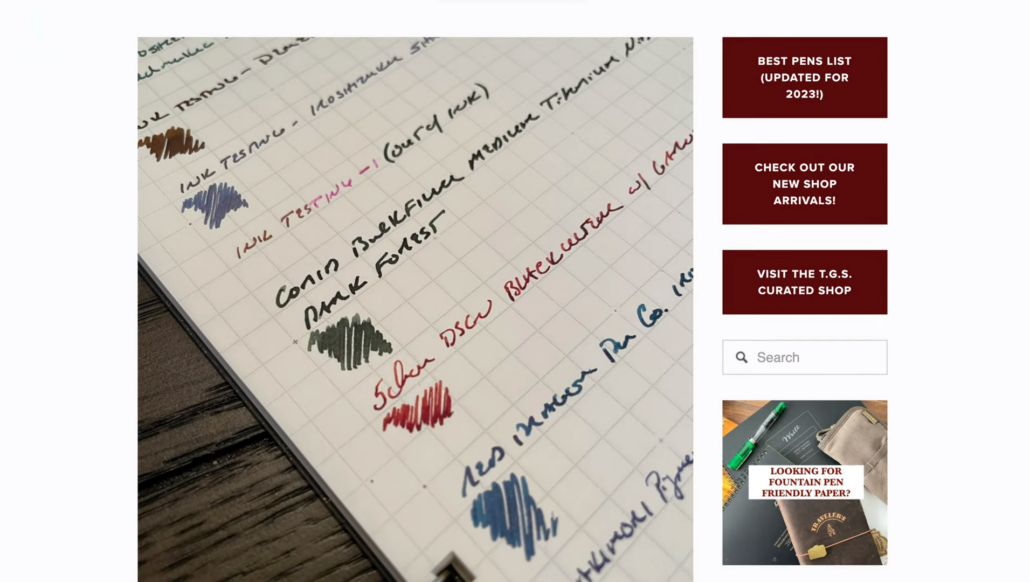
Yes, there are smaller brands that I’m sure make excellent fountain pens, but of course, you also have larger brand names that have been in the fountain pen business for years, and you will know what you get there.
For famous brands, for example, you could look at Mont Blanc, which are definitely pricier but carry a certain prestige. But there are also other brands, like Cartier, Caran d’Ache, Faber-Castell, Lamy, Pelikan and so forth, which all make excellent pens.


My very first Mountain pen was a Lamy one that cost five dollars that I used in elementary school. My first upscale fountain pen was an Omas 360 that I bought on eBay. Since the experience wasn’t so much nicer than my five-dollar fountain pen, I sold it again on eBay for a profit.

So, I quit my paperboy job and bought and sold fountain pens, and one day, I came across a lot of Mont Blanc fountain pens that contained some cufflinks, and that sparked my interest in classic menswear, which then led me to start the Gentleman’s Gazette. So, here you have it — the fountain pen started this business.
If you’re more on a budget, looking at smaller brands such as Kaweco or Ancora can be a really great way to get a lot of value for your money. Also, once you get a grasp on different brands, you see if you like a certain aesthetic, or the materials they use, or the detailing on them. Again, it’s a very personal thing. Some people like the old black Mont Blanc fountain pens, and others want something more exotic.

4. Research Reputable Dealers
Why is that? At a time when you can buy pretty much anything online, why would you want to go to an actual store? Well, yes you can research all sorts of things; specs, sizes, material, content, and so forth online, but when you hold a pen, how the weight is distributed especially in your hand, and the way you write is not something you can understand by just doing online research.
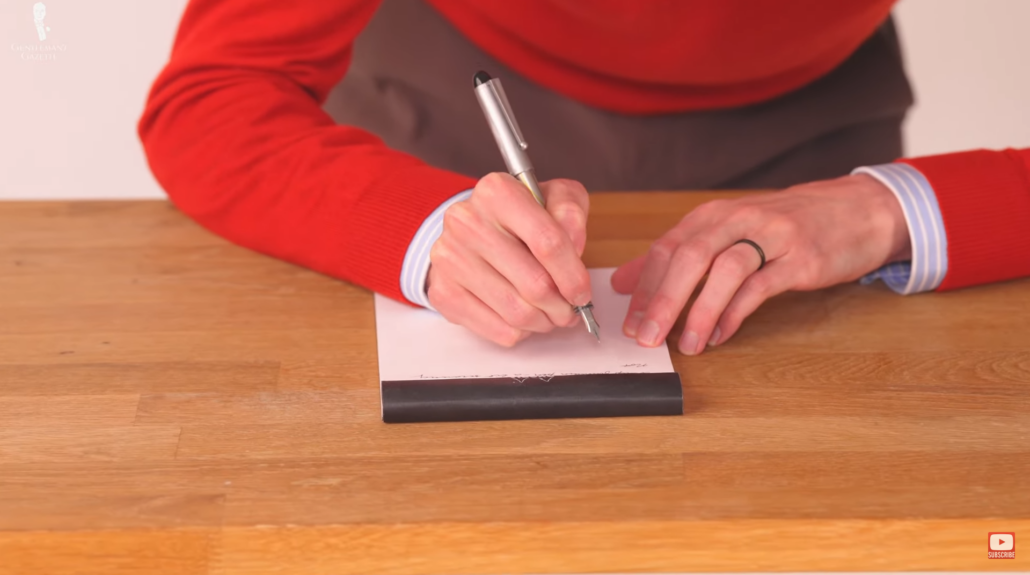
You probably won’t believe how much difference the weight and the weight balance makes when writing with a pen. I have relatively big hands, so writing with a small fountain pen, especially for anything longer than a signature, can be quite painful very quickly.
When you’re at the fountain pen shop, they can guide you in different directions, but you can also write with them, so you can see what your handwriting looks like with different nib widths, with different fountain pens, and even with different ink colors.
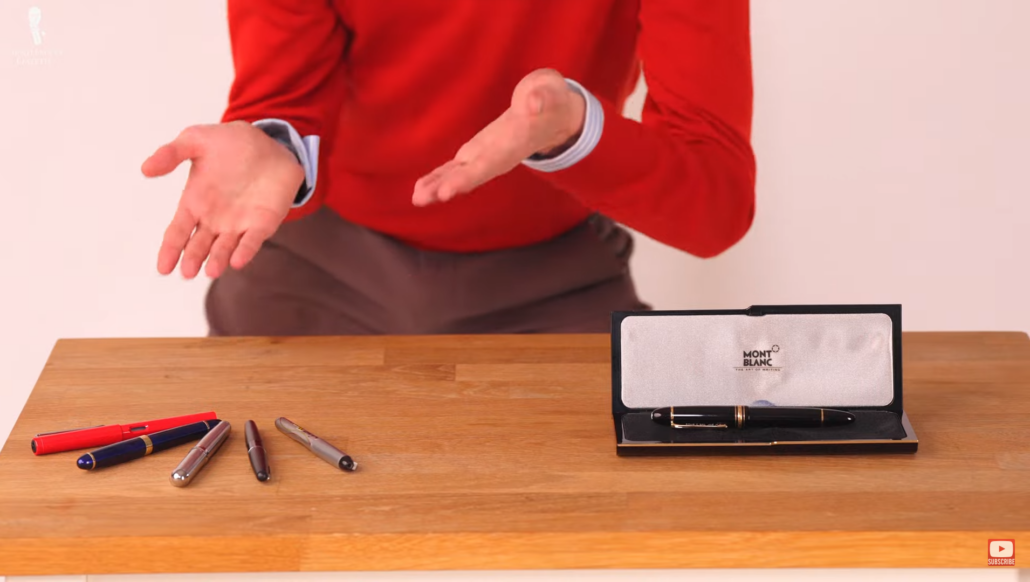
Typically, fountain pen shops also carry a range of different pens. Sometimes, they’ll even have vintage pens, which can be quite different than modern fountain pens, and the proof is really in the pudding. Take them, write them, get an understanding of what you like and what you don’t like. Of course, they may still try to push the sale, but having watched this video, you will be more confident that you have a basic understanding of what to look for.
5. Determine Your Writing Style and Desired Writing Experience

A fountain pen should complement the way you write, so you enjoy it and use it more often. Are you right-handed or left-handed? Does your hand typically cramp up when you write, or can you write a lot by hand without any issues? Do you mostly print? Do you mostly write in cursive, or do you do both? Do you intend to write for longer periods of time? What kind of paper do you want to write on, just simple printer paper or nice, cotton stock that is thick and luxurious?
Also, being aware of the terminology and what you want will help you explain to the salesperson the fountain pen store what it is that you’re looking for.
6. Select features based on needs and intended use
So, once you’ve determined them, in step six, it’s time to pair your characteristics with fountain pen features. For more in-depth assessments of these, we already did a fountain pen guide, which you can check out here.
The Fountain Pen Guide
Nib
A very important part of a fountain pen is the nib, which sits on the ink feed. It is a finely crafted piece of metal, typically on top of something else. It can be a plastic, it can be different material, but it basically gets the ink from the main compartment. It could be a piston, it could be a cartridge to the nib, and then onto the paper.
The nib is a very delicate thing, so you should never push on it or hold it from the side, because not only will your fingers get dirty, but you can also change the characteristic of how the pen writes.
By far, the most popular nib size is M for middle or medium. If a fountain pen doesn’t say what nib with it is, chances are, it is M. There are also finer nibs, which are EF and F, extra fine and fine, and there is broad, BB – broader and 3B, which is even broader.

Especially with the broader nibs, you can see a difference between the horizontal and the vertical lines, and as you write, especially cursive, it can look quite attractive. It’s also really nice for signatures.
But then there’s not just the widths, but there’s also something called oblique nibs, which is basically a slanted nib, so it can be for a right-handed person or left-handed person. There are italic nibs or stub nibs, which are very wide and more meant for calligraphy. Again, there is no universal right or wrong. You have to try it out and see what you like with your handwriting, and things can change over time.


When I started out, I think I liked broad nibs because they were more unique, and then later on, I switched to extra fine. Sometimes, manufacturers can also exchange a nib, but I found it can be quite costly. You’re probably better off just buying a different pen and selling the one that you have. Personally, I like my handwriting to be not run-of-the-mill, so I try to avoid medium nibs or M nibs, because that’s what most other people have.
Other than personal preferences, there are also certain reasons to go with one nib over the other. For example, if you like extremely thin or small letters, EF is a great nib size for you.
If you write lots of Asian characters, EF is a great nib because it allows you to be very detailed and draw fine lines. A BB nib may be the wrong nib for you, in that case. The strokes, of course, also appear very thin and uniform, so maybe you like that, maybe you don’t.
As the nibs get broader, they get visually more varied, and therefore to many people, more interesting. But a broader nib also delivers a lot more ink to the paper, and if the paper is not suited to that, it will bleed and look fuzzy and very ugly. So, if you often have to write on standard printing paper or you can’t control the paper, you’re better off with a fine nib that distributes less ink, so it works in most situations. Also, when there is more ink on your paper, you’re more likely to smudge the ink or have it end up on your hands, and not the way you want it on the paper.

The nibs of less expensive fountain pens are typically made out of steel or other metals. Higher-end fountain pens typically have a nib made out of gold because it’s a more flexible material, and with different pressure, it provides a nicer comfort when you write, and also a nicer result. The nib can also have very different grinds. There are round nibs, stub nibs, daily italic, cursive italic, architect italic, sharp italic, or crisp italic nibs. Again, it’s best to experience these different nib grinds in person so you know what works for you and what doesn’t.
If you see numbers on the nib, it typically refers to the metal alloy. 750 is the equivalent of 18 karat in gold. 585 is the equivalent of 14 karat, and so forth. Because of the high price of gold and the workmanship needed to create a great nib, a fountain pen with a gold nib will set you back several hundred dollars, at least, simply because of the amount of gold that is in it.
So what’s a stub nib? It basically looks like it’s cut in the front, but it has rounded edges. It provides some line variation, narrow horizontal strokes, and broad vertical strokes and is relatively easy to use.

An italic nib, at first glance, looks like a stub nib, but it has straight edges that lead to narrow horizontal strokes and broad vertical strokes, with a greater relative variation in stroke thickness. It also leads to a somewhat less smooth writing experience. Because it’s very responsive to pressure, it’s usually better for calligraphy purposes.
An architect nib is somewhat of the reverse to the stub or italic nib. It creates broad horizontal and thin vertical strokes. It’s great for print or boxy handwriting. Originally, it was used by architects and engineers for drafting, hence, the name. It must be held at a certain angle for the best effect, and it requires some training on your part. So, probably not the best pen to start out with, unless you know exactly what you want.
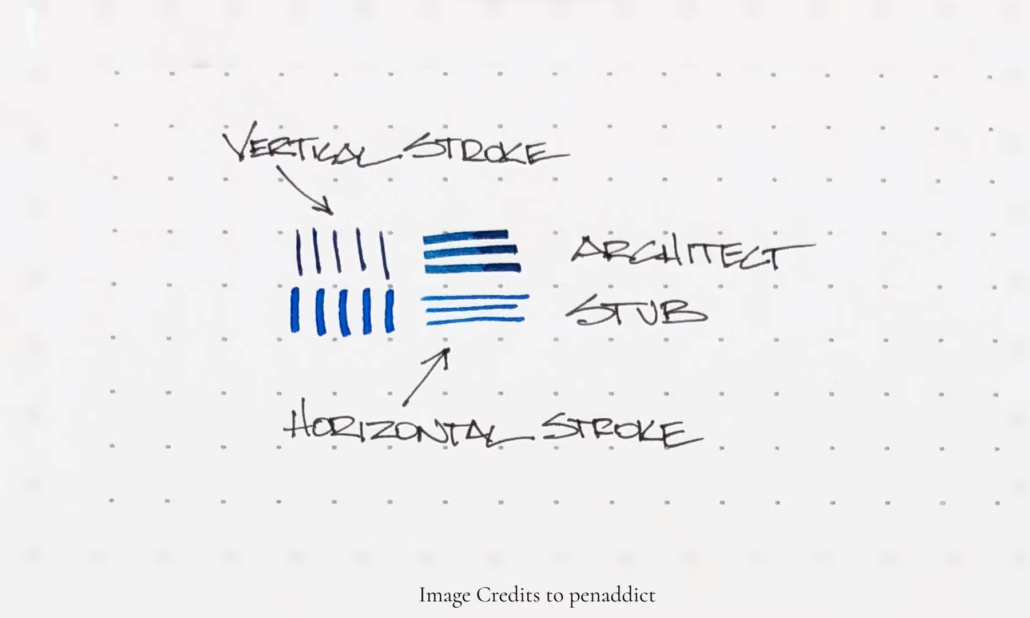
There’s also the inverted architect nib, which is an EF nib with an architect grind. It’s a good option if you need radically different stroke breadths in one nib, but it’s not an ideal grind for beginners.
Then there’s the Hebrew nib, which is very similar to an architect nib, but it’s designed to write Hebrew and Arabic letters better.
And then as I mentioned before, there are the oblique nibs, which are slanted either for left-handed people or right-handed people. OB nibs or OBB nips or OBBB nibs are often favored by calligraphers.
Grind
There are probably dozens of more grinds available there are even bespoke grinds, but when you’re just starting out, you probably don’t want to think about all that stuff. Just go to a store, see what’s available, and start from there. If you want to learn more about the softness of a nib, and how that impacts everything, check out our how to write with a fountain pen guide.
How to Write with a Fountain Pen
Or, if you want to go down the rabbit hole, The Gentleman Stationer explains in detail what he does, and it’s nice to learn from someone who’s truly passionate about the subject matter.
Personally, at one point, I had north of 100 fountain pens, but as my interest in classic menswear increased, my interest in fountain pens decreased. I still have a few to this day, and I enjoy them, but I mostly use them for signatures.
Ink Filling System

Unlike ballpoint pens, the variety of ink you can get from fountain pens is huge, and I consider it to be an advantage because you can truly customize the way your writing looks. No, it doesn’t just have to be black or royal blue. You can have a malachite green, orange or just ocher, or chartreuse.
This ink has to be stored somewhere. Traditional methods include a piston filler, where you basically hold the top of the nib into an inkwell, and then turn or push on something, and the ink is basically soaked inside the fountain pen. We showed you how to do that in our other video. These days, the most popular option is probably the ink cartridge, so you can just buy the cartridge in different colors and then just put them into your fountain pen.

When I was little, my mom would take a syringe from the hospital, take an inkwell, suck the ink into the syringe, and push it into my cartridge so I could reuse them, and that was a lot less expensive than buying new cartridges over and over again. There are also eye-dropper fountain pens, but I suggest you stick either with the ink cartridge or the piston to start out with, because they’re simpler. There’s just a lot to explore.
If you want unique inks and unique colors, you definitely want the piston, unless you want to refill the ink cartridges one by one, as my mom did back in the day. If you want to learn more about ink, we got a writing ink guide and also a stationary guide.
Handwritten Sentiments: The Gentleman’s Stationery Guide
Pen Body

In terms of the material of the main body, also called the barrel, there are lots of different options. You can have plastic, which is very common. You can have rubber or ebonite. There’s somewhat lightweight and have a solid grippy feel. Sometimes you also find pens made of metals, sometimes even precious metals. Often, it’s just a casing. Otherwise, they’d be way too heavy.
Another popular material these days is resin, which for example, the Mont Blanc Meisterstück is made from, and it’s a good material for beginners. Personally, my favorite material is celluloid because it allows for this kind of marbled unusual color effects that I find very pretty.

When it comes to the cap, your biggest concentration is probably if it is a screw-on cap or a push-on cap, and if you want to put the cap on the back of the barrel when you write or not.
Having collected fountain pens, putting the cap on the back of the barrel when you write will eventually lead to cracks in the cap. So, I personally never did that. Also, if you add the cap to the back of the fountain pen, it distributes the weight dramatically. So, try it out and see what works for you.

If you plan to actually use the clip that is on the cap to clip it into your jacket, for example, or into your shirt, make sure it works with the garments you want to use them with, because there’s differences in the clips; some are sturdier, some are stiffer, some are softer – just figure out what works for you.
Maintenance
In terms of maintenance, fountain pens typically require a bit more maintenance than, let’s say, a ballpoint pen. For example, if you leave your ink in your fountain pen and you don’t write with it, it may dry in, and so on.
Design
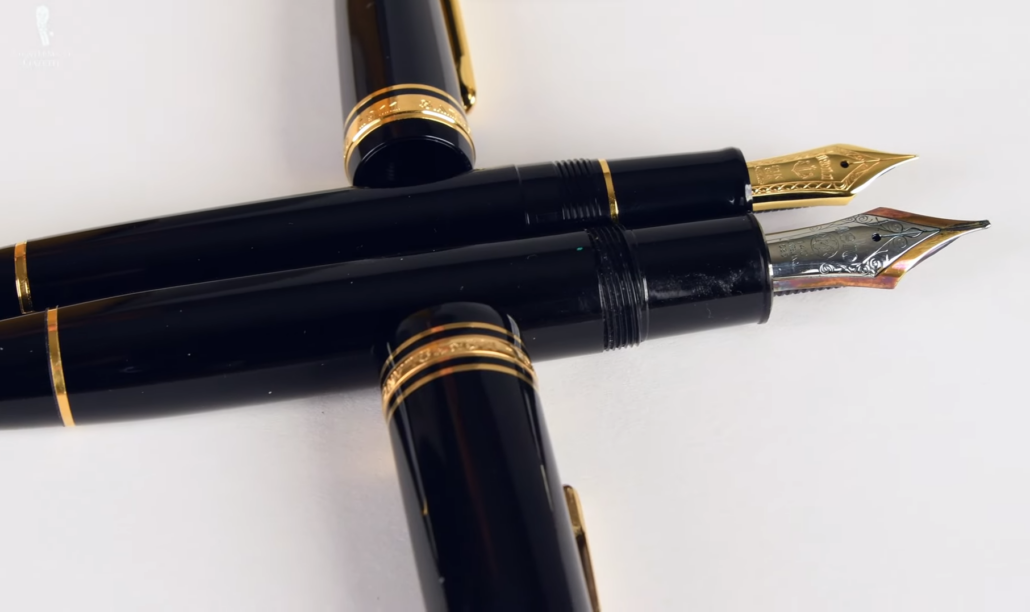
In terms of design, it’s really up to you if you want more of a classic-looking fountain pen or something more modern.
Where To Buy Your First Fountain Pen
If at all possible, I strongly argue in favor of a local dealer, but if online is your only option, here’s what to consider. I’d say, reach out to them by email or phone, maybe they have any options to send you a number of tester fountain pens in exchange for a deposit, so you can try a few things out at home. Figure out what works for them.

Of course, if they’re closer to your home and not abroad, you don’t have any customs and duties issues. So, that’s preferable. Of course, if you’re just putting a few dollars on a fountain pen, you may just want to risk it; buy one and see if you like it, if not, you just move on.
Fountain Pen Dos & Don’ts
1. Do Listen to the Advice from a Reputable Salesperson

They know their stock of starter into fountain pens, and they can guide you as you tell them what you need.
2. Do Make Informed Decisions
Spend time to research, and since you’re watching this here, you’re already doing that. Congratulations!
3. Do Try a Variety of Pens Before Making the Selection

Do try a variety of different nibs, grinds, and widths before you settle on something. It’s simply hard to say, “This is best for me,” if you haven’t tried them all. Also, keep in mind that the nib designations of medium, fine, or broad may not be the same across different brands. Generally, Japanese nibs tend to be a little finer than more Western manufacturers’ nibs.
4. Don’t Assume the Most Expensive Equals the Best

Don’t just buy the most expensive fountain pen, and think it’s the best for you, because even though it may look nice, it has a gold nib, it may be horrible to write with your hand.
5. Do Buy a Pen You’re Willing to Use (and Perhaps Lose!)

I’d say, it’s your first fountain pen, do buy a pen that you’re willing to use and also lose. If you buy something that is too expensive, and you never want to take it with you because you feel you might lose it, then it’s kind of pointless.
Ultimately, a fountain pen is a writing instrument, and yes, they’re beautiful examples. For example, the limited edition one from Montegrappa for James Bond might not be for you.
6. Avoid Vintage for Your First Buy
Vintage fountain pens are nice. I personally prefer them over modern fountain pens, but there are a lot more things to learn about them, so you just buy an old pen off of eBay or at a flea market; chances are it’ll need some work.

So, I’d only recommend buying a vintage fountain pen in person from someone who has many vintage fountain pens and know something about them, and can guide you along the way, based on your needs. Otherwise, it’s probably not wise to go vintage if you buy your very first fountain pen. Why? There are simply too many pitfalls, and chances are, you won’t enjoy writing with them.
7. Don’t Make Beginner Fountain Pen Mistakes
Lastly, don’t make beginner fountain pen mistakes, as outlined in our other guide.
Beginner Fountain Pen Mistakes
So, what do you think is your first fountain pen going to be? Let us know in the comments below.
Outfit Rundown
Today, I’m wearing a double-breasted brown sport coat with a double windowpane overcheck. It’s made by Isaia, and you can learn more about the brand in another post. My shirt is from Eton, which we also covered.
The tie is from Fort Belvedere, just like the yellow boutonniere. It’s a silk knit tie, and you can find them both in our shop, just like my socks. These are shadow stripe socks in khaki and navy, which work well with my chino pants, which are a prototype cut that we will hopefully launch soon.
My shoes are Gaziano & Girling Barclays in dark chocolate suede with contrast stitching. My pinky ring is nicely decorated with a brown tiger’s eye that picks up the color of my jacket, my shoes, and my white-beige brown striped shirt.
My fountain pen is a Mont Blanc Meisterstück 149, which is probably 30 years old. It has an OB nib, which is slanted, and I’m right-handed, so it works for me.






I have five fountain pens, two Cross, a Scrivener, a Mount Blanc, and a Levenger. All with medium nibs except the Levenger, (F) and one Cross, (B). I use all of them as I hand write all my correspondence, and thank you notes. To date my favorite is the Scrivener; great balance and smooth writing. I use Mount Blanc ink exclusively.
Thanks for an excellent overview on fountain pens. It brought back some nice memories and some not so nice ones. Back in the late 80s I bought a spectacular Waterman Opera set including a fountain pen and ballpoint. They were so beautiful it was hard to imagine how they made such lovely products. I enjoyed them for many months. Then within a year, the fountain pen stopped working properly despite my gentle treatment. It leaked and the barrel wouldn’t screw on properly, and other things fell off. I took it into the best repair shop in NYC and they said they had a ton of returns on these pens, and that the workmanship was not very good. They took it for repairs but they said it would be a long time before I got it back. I did get it back after more than a year, but I used it only a few times and had trouble again, so I put it away and haven’t used it since. The ballpoint got stolen. Since then I don’t use fine writing instruments that cost a lot. For fountain pens I just have a Pilot and a Parker sterling pen that sits in my desk at home. The thrill is gone as B.B. King said.
I started using fountain pens back in the Sixties. They are still my favorite instrument for writing. I tried newer pens, but gave them away. I just couldn’t be happy with them. I have “a few” vintage pens. A variety of brands. Okay, my wife calls it hoarding.
Anyway, I have to disagree with not going vintage with your first fountain pen. The Parker 21’s are fine beginner pens, especially the Mark II pens. The sack on these pens seem to just keep going, and they are easy to fill, even after 70 years. Furthermore, the clip has to be the most usable, though not sexy, clip ever designed. Plus, they feel and write great. I use one as my EDC. For the more advanced, I haven’t found ANY pen that writes better than an original Parker Duo-Fold. But it definitely pays to buy a restored example unless you rebuild vintage fountain pens.
Fountain pens aren’t much fun when you’re left-handed and your hand follows the freshly-applied ink. When I write backwards from right-to-left I get good results. Unfortunately, this doesn’t seem to have much practical application in the modern world….or any other world for that matter.
If you were writing Arabic or Hebrew.
my first fountain pen at age 9 was a shaeffer no nonsense pen. My Mother gave me her waterman’s pen from the ’40’s, but I’ve been using them all my life. My favourite model is a lady Shaeffer black and gold criss cross pen with a gold nib and I am obsessed with my Cross Townsend sterling silver fountain pen but I’m truly in love with both the Parker Vector and the Parker sonnet (sterling silver barrel with gold nibs). I have lots of other pens but these are my favourites
Thank you for your insights.
I’ve used fountain pens since Primary (Junior) School. An Osmiroid lever-fill, then a Parker 51 (Mk ii, I believe) for about 20 years, then a 144 Montblanc that my daughter now uses. I currently use a Waterman Gentleman with the extra-fine nib. The Waterman is a lovely pen to use.
I flush the converter/piston/filler every 3rd or 4th fill of ink. I also use Montblanc ink.
I have invested in a leather pen case/pouch/etui, to keep any pens separated whilst in my top pocket or bag. In that way, the pen may survive unscathed if it falls onto a hard surface and the baffle inside the pen case isolates the pens from each other and from sharp objects.
Again, thank you for your fine article.
I have used numerous fountain pens, including Mont Blanc, and Parker, but the best and most reliable for me is a Waterman.
I much prefer writing with a fountain pen to any roller ball or ballpoint and try to do so wherever possible. My first ‘proper’ fountain pen was a gold filled Parker 61 in the cirrus design and that sort of set me on a life-long preference for that brand and although I have a 75 ball pen as my edc my favourite fountain pen in a lowly Parker 25. I have 4 Parker 25 fountain pens now including a gold filled one (along with ball pens and pencils) but my original stainless steel P25 is still my favourite which gets used disproportionally more than any of my ‘better’ ones.